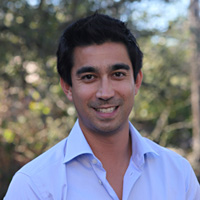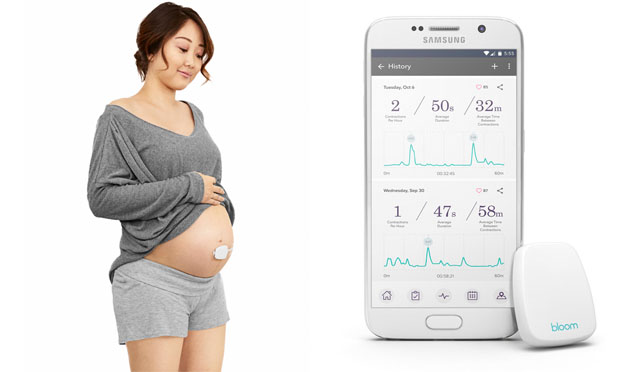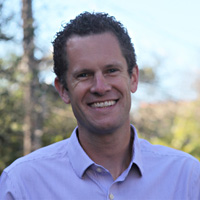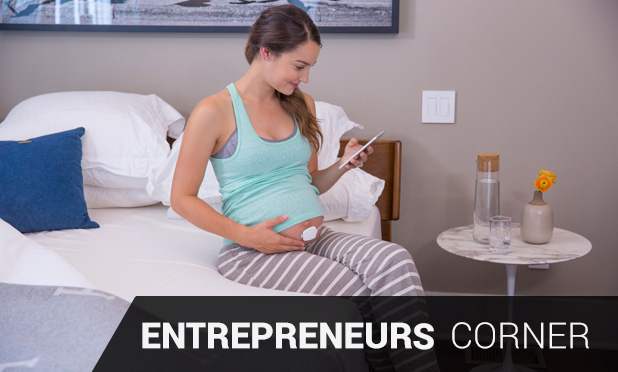Above: Expecting mom in bed with Belli. There are two parts to the sensor, a reusable sensor and disposable patch. The sensor communicates to a smartphone app where mom can get need to know information about her body and her baby. User data is further analyzed in the cloud backend to provide moms with personalized tips towards healthy choices based upon her own biometric data.
Recent advances in healthcare technology seem to follow two main trends. First is a slow but steady shift away from institutional settings such as hospitals and clinics to more personalized, consumer-like settings. Second is a trend toward “analytics.” The ability to comb through massive amounts of data to discern meaningful patterns constitutes a key competitive advantage from a business perspective while allowing for better care from a clinical perspective. Bloom Technology, a startup based in the San Francisco Bay area, California, has built its core strategy on these two trends. Their “wear-track-share” motto clearly describes the mission of their main product, Belli, which is a digital pregnancy coach. IEEE Pulse Deputy Editor in Chief, Ahmed Morsy, had the opportunity to speak with Bloom Technology founder and CEO, Eric Dy, about this innovative company.
Morsy: I know that Bloom Technology is a spin-off from the Belgian research center IMEC. Tell me about the founding story of Bloom.

Dy: The team behind Bloom has been developing some of the most advanced wearables for consumer and medical markets over the past decade while working at the Belgian-based research center IMEC. My co-founder, Julien Penders, built and led IMEC’s Body Area Networks team and I was working in business development for our Smart Systems Business Line when we got a chance to start working together. We immediately hit it off, both being fast-talking, high-energy people who had a desire to start a company within the emerging consumer health space. We were looking for opportunities where our expertise in developing clinically accurate wearables would be of high value, where quality and accuracy of data would be paramount, and where the data you could collect from a consumer market could help solve unmet medical problems.
At that time, Julien’s wife, Ludivine, became pregnant with their first child and a lightbulb went on. Few people care more about their health and have more questions about what’s going on with their bodies than pregnant women. When we started digging into the medical side, we were amazed at how little was known about pregnancy, and in particular, the high incidence of preterm birth. There is a serious lack of data to help researchers understand pregnancy and disease such as preterm birth and we felt we could develop technology that met the needs of both moms and doctors.
We formed the company in January 2014 and chose to be based in the San Francisco Bay Area because I was living in San Francisco at the time and we felt that U.S. consumers would likely be the earliest adopters or our technology.
Morsy: How does the technology actually work?
Dy: Bloom has developed the first wearable designed specifically for women that measures contractions in expecting moms. Expecting moms have contractions throughout the third trimester and until now had to rely on unreliable self-diagnosis to track them. Our device uses a simple yet powerful wearable sensor that can measure frequency, duration, and intensity of contractions. Bloom also plans to release algorithm updates to distinguish between Braxton Hicks and labor-inducing contractions as well as track other parameters of fetal and maternal health.

Morsy: How would you describe the initial market acceptance/resistance? And how did that change over time?

Dy: Bloom combines pregnancy-specific wearables with data analytics to reassure moms and provide doctors with better information to improve decision-making. The reaction from mothers has been overwhelmingly positive. Many pregnant women crave more information and we will provide an accurate and reliable means of answering questions around their health and the health of their babies.
Doctors’ reactions have been mixed. I think they are used to digital health companies offering to send them continuous streams of biometric data from users, but it’s clear that this is the opposite of what doctors want. They are already overwhelmed with information, so it’s not about more information but more timely information that they can act upon. We have found that, if given the time to share with doctors our vision for collecting the missing clinical data to better predict and manage pregnancy complications such as preterm birth, that they will admit while there is a lot of validation still to be done, our approach makes sense. It may be the best way to solve these complex diseases we have struggled with to date.
Morsy: It is interesting that during the Apple fall event in September 2015, part of the keynote was used to address fetal monitoring. Do you see Apple as a partner or a mega competitor?
Dy: It was a pleasant surprise. Apple spent eight minutes of their keynote talking about remote fetal monitoring that communicated to their Apple Watch. The fetal monitoring was enabled by a competitor of sorts, which many might consider a problem given Apple’s impact. However, we viewed this as a great endorsement of the prenatal health market. If there is no competition, after all, perhaps the market isn’t such a great one to go after.
Morsy: How did you deal with the funding challenge?
Dy: Raising money for a women’s health company, and in particular one working in prenatal health, was not easy, especially since we are situated at the intersection of consumer and medical markets. For medical investors we didn’t have enough clinical evidence. For consumer investors, we didn’t have traction. That being said, we were fortunate enough to raise US$2.5M to date with a great mix of European and U.S. investors who are as passionate as we are about resolving the health problems associated with pregnancy.
I should also mention that we supplemented our initial fundraising with a $250k non-dilutive grant from the Flemish government, which helped greatly in the early days.
Morsy: Is there any mistake that you made early on that can share with me?
Dy: I’d say the biggest mistake we made early on was not staying focused enough. As entrepreneurs, we have big dreams and ambition but at an early stage we had only small teams and limited resources. We were trying to do too much early on and nothing progressed at the speed we needed. What is really key is cutting down your product to its bare essential to get a prototype that can be tested as fast as possible with users. Even now we battle ourselves to distill the minimum viable product so we can continue to iteratively test.
Morsy: What kind of advice would you share with potential future entrepreneurs?
Dy: Healthcare technologies can address more than pure medical markets these days. The consumerization of health care is creating lots of opportunities for innovative business models. But in the end, if you want to become integrated into clinical practice you need to do your homework and not only understand the needs of consumers but also the needs of doctors. While the road to endorsement and adoption by doctors is a long one, if you are successful, it can provide a strategic advantage even if you are targeting a direct to consumer play.
Bloom is looking for talented and passionate engineers and scientists to help them design the future of prenatal care. If interested, please contact them at careers@bloom.life.



